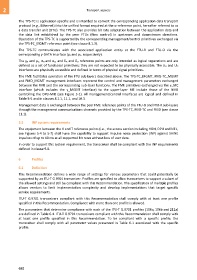Page 698 - 5G Basics - Core Network Aspects
P. 698
2 Transport aspects
The TPS-TC is application-specific and is intended to convert the corresponding application data transport
protocol (e.g., Ethernet) into the unified format required at the α-reference point, hereafter referred to as
a data transfer unit (DTU). The TPS-TC also provides bit rate adaptation between the application data and
the data link established by the peer FTUs (flow control) in upstream and downstream directions.
Operation of the TPS-TC is supported by the corresponding management/control primitives exchanged via
the TPS-TC_MGMT reference point (see clause 8.1.3).
The TPS-TC communicates with the associated application entity at the FTU-R and FTU-O via the
corresponding γ-DATA interface (γR and γO, respectively).
The γR and γO, αR and αO, and δR and δO reference points are only intended as logical separations and are
defined as a set of functional primitives; they are not expected to be physically accessible. The UR and UO
interfaces are physically accessible and defined in terms of physical signal primitives.
The FME facilitates operation of the FTU sub-layers described above. The TPS-TC_MGMT, PMS-TC_MGMT
and PMD_MGMT management interfaces represent the control and management parameters exchanged
between the FME and the corresponding sub-layer functions. The FME primitives exchanged via the γ_MC
interface (which includes the γ_MGMT interface) to the upper-layer ME include those of the NMS
controlling the DPU-MIB (see Figure 5-1). All management/control interfaces are logical and defined in
Table 5-5 and in clauses 8.1.1, 11.1, and 10.3.
Management data is exchanged between the peer FME reference points of the FTU-O and FTU-R sub-layers
through the management communications channels provided by the TPS-TC, PMS-TC and PMD (see clause
11.1).
5.5 INP system requirements
The equipment between the V and T reference points (i.e., the access section including HON, DPU and NT1,
see Figures 5-4 to 5-7) shall have the capability to support impulse noise protection (INP) against SHINE
impulses of up to 10 ms at all supported bit rates without loss of user data.
In order to support this system requirement, the transceiver shall be compliant with the INP requirements
defined in clause 9.8.
6 Profiles
6.1 Definition
This Recommendation defines a wide range of settings for various parameters that could potentially be
supported by an ITU-T G.9701 transceiver. Profiles are specified to allow transceivers to support a subset of
the allowed settings and still be compliant with this Recommendation. The specification of multiple profiles
allows vendors to limit implementation complexity and develop implementations that target specific
service requirements.
ITU-T G.9701 transceivers compliant with this Recommendation shall comply with at least one profile
specified in this Recommendation. Compliance with more than one profile is allowed.
The parameters that determine compliance with each of the ITU-T G.9701 profiles (106a, 106b and 212a)
are defined in Table 6-1. ITU-T G.9701 transceivers compliant with this Recommendation shall comply with
at least one profile specified in this Recommendation. To be compliant with a specific profile, the
transceiver shall comply with all parameter values presented in Table 6-1 associated with the specific
profile.
688

